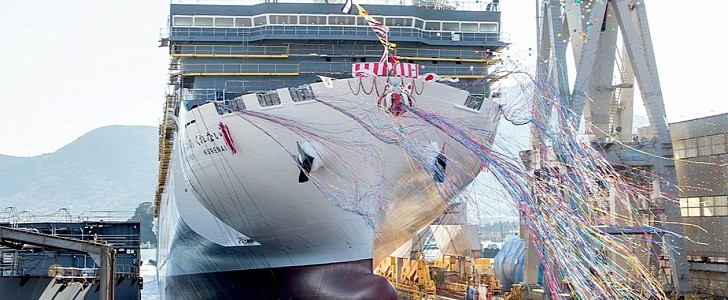On the path to achieving zero greenhouse gas (GHG) emissions by 2050, Mitsui O.S.K. Lines (MOL), a giant player in the maritime transportation industry, is introducing the first dual-fuel ferry in Japan, which can run on LNG (liquefied natural gas).
The MOL Group sees LNG as one of the best solutions available at the moment for reducing harmful emissions linked to shipping, and it has the very ambitious plan of launching no less than 90 vessels operating on this alternative fuel by the end of the decade. Two years ago, it announced that three of its future LNG-fueled vessels had been awarded a top five-star rating by Japan’s Ministry of Land, Infrastructure, Transport and Tourism, based on environmental performance.
One of these three ships was the Sunflower Kurenai, a pioneering LNG-fueled ferry that is now officially launched. The naming and launching ceremony was recently held at Mitsubishi Heavy Industries’ plant at the Yamaguchi Prefecture. Sunflower Kurenai is meant to replace the existing ferry currently operating on the Osaka-Beppu route, starting January 2023.
Claiming to be Japan’s first ferry running on this alternative fuel, MOL’s new vessel is expected to reduce CO2 emissions by 25%, while completely eliminating sulfur oxide (SOx) emissions when operating entirely on LNG. The ship’s high-performance dual-fuel engine can run on LNG, as well as conventional heavy fuel. It’s longer than the current ferry (652 feet/199 meters, compared to 502 feet/153 meters) and heavier (17,300 tons versus 9,245), boasting a bigger capacity for both cargo and passenger transportation.
The new ferry was also designed with an extended pilot’s room, for increased comfort, a double floor area of the Grand Bathroom, and an increased number of seats in the restaurant. Passengers will also be able to enjoy a new three-layer atrium.
The Sunflower Kurenai will be followed by a second LNG-fueled ferry, the Sunflower Murasaki, in 2023. In addition to these eco-friendly ferries, MOL has also developed Ishin, an LNG-fueled tugboat, and Energy Frontier, the world’s largest MOSS-type LNG carrier.
One of these three ships was the Sunflower Kurenai, a pioneering LNG-fueled ferry that is now officially launched. The naming and launching ceremony was recently held at Mitsubishi Heavy Industries’ plant at the Yamaguchi Prefecture. Sunflower Kurenai is meant to replace the existing ferry currently operating on the Osaka-Beppu route, starting January 2023.
Claiming to be Japan’s first ferry running on this alternative fuel, MOL’s new vessel is expected to reduce CO2 emissions by 25%, while completely eliminating sulfur oxide (SOx) emissions when operating entirely on LNG. The ship’s high-performance dual-fuel engine can run on LNG, as well as conventional heavy fuel. It’s longer than the current ferry (652 feet/199 meters, compared to 502 feet/153 meters) and heavier (17,300 tons versus 9,245), boasting a bigger capacity for both cargo and passenger transportation.
The new ferry was also designed with an extended pilot’s room, for increased comfort, a double floor area of the Grand Bathroom, and an increased number of seats in the restaurant. Passengers will also be able to enjoy a new three-layer atrium.
The Sunflower Kurenai will be followed by a second LNG-fueled ferry, the Sunflower Murasaki, in 2023. In addition to these eco-friendly ferries, MOL has also developed Ishin, an LNG-fueled tugboat, and Energy Frontier, the world’s largest MOSS-type LNG carrier.




